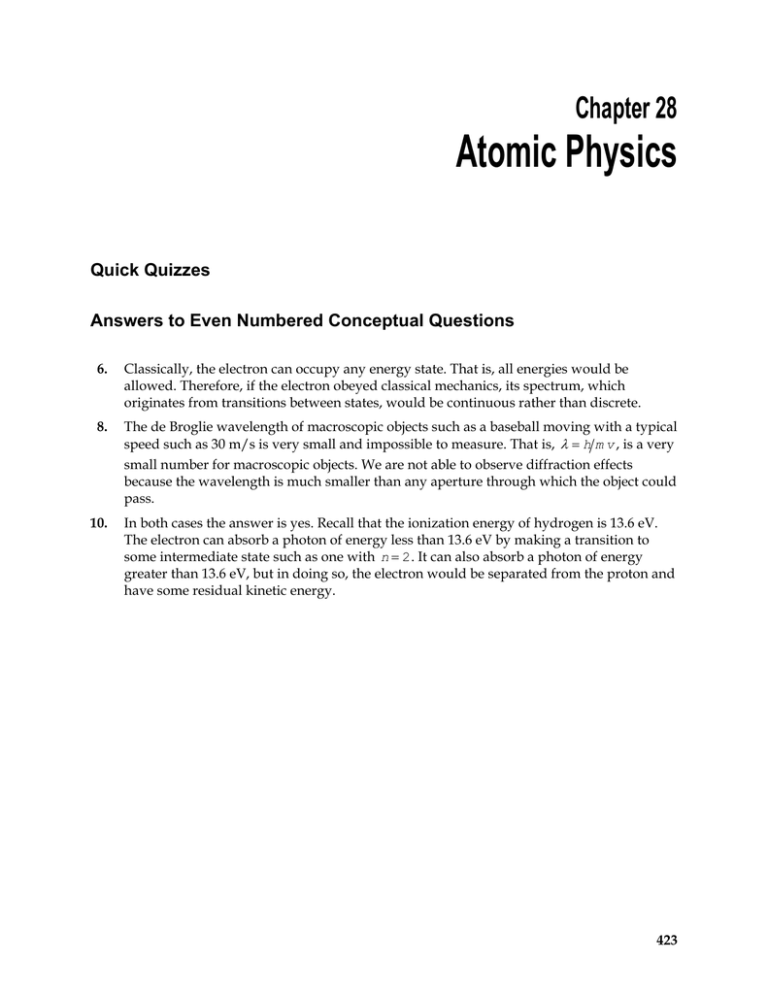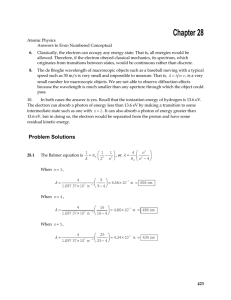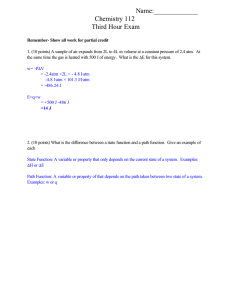Atomic Physics Chapter 28 Quick Quizzes
advertisement

Chapter 28 Atomic Physics Quick Quizzes Answers to Even Numbered Conceptual Questions 6. Classically, the electron can occupy any energy state. That is, all energies would be allowed. Therefore, if the electron obeyed classical mechanics, its spectrum, which originates from transitions between states, would be continuous rather than discrete. 8. The de Broglie wavelength of macroscopic objects such as a baseball moving with a typical speed such as 30 m/s is very small and impossible to measure. That is, λ = h m v , is a very small number for macroscopic objects. We are not able to observe diffraction effects because the wavelength is much smaller than any aperture through which the object could pass. 10. In both cases the answer is yes. Recall that the ionization energy of hydrogen is 13.6 eV. The electron can absorb a photon of energy less than 13.6 eV by making a transition to some intermediate state such as one with n = 2 . It can also absorb a photon of energy greater than 13.6 eV, but in doing so, the electron would be separated from the proton and have some residual kinetic energy. 423 424 CHAPTER 28 Problem Solutions 28.1 The Balmer equation is 4 ⎛ n2 ⎞ ⎛ 1 1⎞ = R H ⎜ 2 − 2 ⎟ , or λ = ⎜ ⎟ R H ⎝ n2 − 4 ⎠ λ ⎝2 n ⎠ 1 When n = 3 , 4 1.097 37 × 107 m λ= −1 ⎛ 9 ⎞ −7 ⎜ ⎟ = 6.56 × 10 m = 656 nm ⎝ 9− 4 ⎠ When n = 4 , 4 1.097 37 × 107 m λ= −1 ⎛ 16 ⎞ −7 ⎜ ⎟ = 4.86 × 10 m = 486 nm ⎝ 16 − 4 ⎠ When n = 5 , 4 1.097 37 × 107 m λ= 28.3 −1 ⎛ 25 ⎞ −7 ⎜ ⎟ = 4.34 × 10 m = 434 nm ⎝ 25 − 4 ⎠ (a) From Coulomb’s law, F= ke q1q2 r2 ( 8.99× 10 = 9 N ⋅m 2 C 2 )( 1.60 × 10−19 C ) (1.0× 10 −10 m ) 2 2 = 2.3× 10−8 N (b) The electrical potential energy is PE = 9 keq1q2 ( 8.99× 10 N ⋅ m = r ⎛ 1 eV = − 2.3× 10−18 J⎜ -19 ⎝ 1.60 × 10 28.7 (a) 2 C 2 )( − 1.60× 10−19 C )( 1.60 × 10−19 C ) 1.0 × 10−10 m ⎞ ⎟ = − 14 eV J⎠ rn = n2a0 yields r2 = 4( 0.0529 nm ) = 0.212 nm Atomic Physics (b) With the electrical force supplying the centripetal acceleration, m evn2 kee2 kee2 m ekee2 and pn = m evn = = 2 , giving vn = rn rn m ern rn Thus, ( 9.11× 10 −31 m ekee2 = p2 = r2 kg )( 8.99× 109 N ⋅ m 2 C 2 )( 1.6 × 10−19 C ) 0.212× 10−9 m = 9.95× 10−25 kg ⋅ m s (c) ⎛ h Ln = n ⎜ ⎝ 2π ⎞ ⎛ 6.63× 10−34 J⋅ s⎞ −34 → = L 2 ⎟ ⎜ ⎟ = 2.11× 10 J⋅ s 2 π 2 ⎠ ⎝ ⎠ ( 9.95× 10−25 kg ⋅ m s) = 5.44× 10−19 J= 3.40 eV p2 1 (d) KE2 = m ev22 = 2 = 2 2m e 2( 9.11× 10−31 kg ) 2 (e) ( 8.99× 109 N ⋅ m 2 C 2 )(1.60× 10−19 C ) k ( − e) e =− PE2 = e r2 ( 0.212× 10−9 m ) 2 = −1.09× 10−18 J= − 6.80 eV (f) 28.10 E2 = KE2 + PE2 = 3.40 eV − 6.80 eV = − 3.40 eV (b) From ⎛ 1 1⎞ = RH ⎜ 2 − 2 ⎟ ⎜ n f ni ⎟ λ ⎝ ⎠ 1 or λ = λ= (a) E= hc λ 1 RH ⎛ ni2n2f ⎞ ⎜ 2 ⎟ with ni = 6 and n f = 2 ⎜ ni − n2f ⎟ ⎝ ⎠ 1 1.097 37 × 107 m ( 6.63× 10 −34 = −1 ⎡ ( 36)( 4) ⎤ −7 ⎢ ⎥ = 4.10× 10 m = 410 nm − 36 4 ⎣ ⎦ J⋅ s)( 3.00× 108 m s) 410× 10− 9 m = 4.85× 10− 19 J= 3.03 eV 2 425 426 CHAPTER 28 (c) 28.15 f= c λ = 3.00 × 108 m s = 7.32× 1014 H z 410 × 10− 9 m ⎛ 1 1⎞ = R H ⎜ 2 − 2 ⎟ , it is seen that (for a fixed value of n f ) λm ax occurs when ⎜ n f ni ⎟ λ ⎝ ⎠ ni = n f + 1 and λm in occurs when ni → ∞ . From 1 ( ) (a) For the Lyman series n f = 1 , 1 λm ax = ( 1.097 37 × 107 m −1 = ( 1.097 37 × 107 m −1 ) ⎛⎜⎝ 11 − 21 ⎞⎟⎠ → λ = 1.22× 10−7 m = 122 nm ) ⎛⎜⎝ 11 − ∞1 ⎞⎟⎠ → λ = 9.11× 10−8 m = 91.1 nm 2 m ax 2 and 1 λm in m in 2 ( ) (b) For the Paschen series n f = 3 , 1 λm ax = ( 1.097 37 × 107 m −1 = ( 1.097 37 × 107 m −1 ) ⎛⎜⎝ 31 − 41 ⎞⎟⎠ → λ 2 m ax 2 = 1.87 × 10−6 m = 1.87 × 103 nm and 1 λm in ) ⎛⎜⎝ 31 − ∞1 ⎞⎟⎠ → λ m in 2 = 8.20× 10−7 m = 820 nm Z 2 ( 13.6 eV ) ( 3) ( 13.6 eV ) , E1 = − = − 122 eV 2 2 n ( 1) 2 28.27 (a) From En = − n2a0 ( 1) a0 0.0529× 10−9 m gives r1 = = = 1.76 × 10−11 m Z 3 3 2 (b) Using rn = Atomic Physics 28.32 (a) For standing waves in a string fixed at both ends, L = or λ = nλ 2 2L h . According to the de Broglie hypothesis, p = λ n Combining these expressions gives p = m v = (b) Using E = En = 28.33 nh 2L 1 2 p2 , with p as found in (a) above: mv = 2 2m n2h2 h2 2 w her e = n E E = 0 0 4L2 ( 2m ) 8m L2 In the 3p subshell, n = 3 and l = 1 . The 6 possible quantum states are m l = +1 m s = ± 12 l =1 ml =0 m s = ± 12 l =1 m l = −1 m s = ± 12 l =1 (a) For a given value of the principle quantum number n, the orbital quantum number l varies from 0 to n − 1 in integer steps. Thus, if n = 4 , there are 4 possible n= 3 n= 3 n= 3 28.34 values of l : l = 0,1,2, and 3 (b) For each possible value of the orbital quantum number l , the orbital magnetic quantum number m l ranges from −l to + l in integer steps. When the principle quantum number is n = 4 and the largest allowed value of the orbital quantum number is l = 3 , there are 7 distinct possible values for m l . These values are: m l = −3,− 2,− 1,0,+ 1,+ 2, and + 3 28.36 427 (a) The electronic configuration for oxygen ( Z = 8) is 1s2 2s2 2p4 (b) The quantum numbers for the 8 electrons can be: 1s states 2s states n=1 n= 2 l=0 l=0 2p states n= 2 l =1 ml =0 ml =0 ml =0 ml =1 m s = ± 12 m s = ± 12 m s = ± 12 m s = ± 12 428 CHAPTER 28 28.41 For nickel, Z = 28 and EK ≈ − ( Z − 1) 2 EL ≈ − ( Z − 3) 2 13.6 eV ( 1) 2 = − ( 27) ( 13.6 eV ) = − 9.91× 103 eV 2 6 eV ) 13.6 eV 2 ( 13. = − ( 25) = − 2.13× 103 eV 2 4 ( 2) Thus, Eγ = EL − EK = −2.13 keV − ( −9.91 keV ) = 7.78 keV and λ= −34 8 hc ( 6.63× 10 J⋅ s)( 3.00 × 10 m s) = = 1.60× 10−10 m = 0.160 nm Eγ 7.78 keV ( 1.60 × 10−16 J keV )











